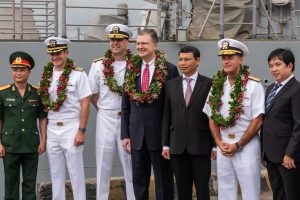This past weekend, Washington’s top diplomat for East Asia embarked on a four-nation tour of Southeast Asia, aimed at shoring up the United States’ relationships with key nations in the region. In a statement late last week, the U.S. State Department said that Daniel Kritenbrink, the assistant secretary of state for East Asia, will pay visits to Indonesia, Malaysia, Singapore, and Thailand, before winding up his trip on December 4.
The agenda for the tour echoes the recent messaging from the Biden administration. According to the State Department, Kritenbrink will reaffirm Washington’s commitment to work with Southeast Asian countries “to tackle the most serious global and regional challenges” and stress U.S. support for “a rules-based order in the Indo-Pacific” – code for opposition to China’s recent assertions of hard power in the region.
Kritenbrink will also “engage allies and partners on regional democracy and human rights challenges,” in addition to seek to discussing cooperation on climate change and the COVID-19 pandemic. The statement added that he will “discuss ways to pressure the Burmese military regime to cease the violence, allow for unhindered humanitarian access, and restore Burma’s path to democracy.”
Kritenbrink, who has previously served as ambassador to Vietnam and Senior Director for Asian Affairs at the National Security Council, is the latest in a string of high profile U.S. personnel to visit Southeast Asia. The past six months has seen regional tours by U.S. Vice President Kamala Harris, Defense Secretary Lloyd Austin, and Wendy Sherman, the deputy secretary of state.
President Joe Biden himself joined ASEAN leaders at a virtual summit last month, after four years of no-shows by his predecessor Donald Trump. Biden pledged to stand with ASEAN in defending freedom of the seas, echoing the comments of Austin and Harris during their respective trips, when they reinforced the U.S. commitment to the nations contesting China’s expansive claims in the South China Sea.
The choice of destinations for Kritenbrink’s tour fills in the gaps left by this year’s earlier diplomatic engagement. Indonesia, the quintessential “Indo-Pacific” nation, did not feature on the itineraries of either Harris or Austin, an omission that raised eyebrows among foreign policy observers in Jakarta. (The Jakarta Post editorial described Austin’s absence as a “snub.”) Ditto Thailand, a U.S. treaty ally that has seen strained relations with Washington due to the authoritarian tendencies of Prime Minister Prayut Chan-o-cha’s government and Bangkok’s seeming indifference to the U.S. attempt to rally its allies and partners to meet the various challenges posed by China.
Over the past year, Beijing has been assiduous in courting Southeast Asian governments, with which it has developed strong economic and relationships over the past two decades. Chinese Foreign Minister Wang Yi has been a perennial feature in the region’s capitals, having visited all 10 ASEAN nations since late 2020, his most recent coming in September.
In contrast to the U.S., which has focused on bolstering security relationships, especially in maritime Southeast Asia, the Chinese government has geared its outreach to the concrete economic public health challenges that have beset the region since the beginning of the COVID-19 pandemic, presenting China as an inexorable partner in the region’s economic recovery.
Despite Biden’s administration stepping up the pace of diplomatic exchanges, economics remains a blind spot in the U.S. engagement with Southeast Asia, a fact highlighted by President Trump’s withdrawal from the painstakingly negotiated Trans-Pacific Partnership (TPP), which has continued without American participation as the Comprehensive and Progressive Agreement for Trans-Pacific Partnership. With the signing of the Regional Comprehensive Economic Partnership in November 2020, the U.S. now finds itself on the outside of Asia’s two major trade pacts.
This shortfall is something that U.S. officials understand. During last month’s ASEAN summit and related meetings, Biden said that the U.S. was beginning to start talks on developing a regional economic framework.
As Daniel Russel, a predecessor of Kritenbrink in the Obama administration, told Reuters last week, a key question for ASEAN was “whether the United States truly has a viable economic strategy” for the region. Such a framework would undoubtedly be welcomed by Southeast Asian governments, who are eager for a counterweight against China but generally resist endangering the economic relationships that they have established with Beijing.
So far there is not much detail about what such a U.S.-led economic framework would look like, especially given the powerful domestic forces arrayed against the U.S. rejoining the TPP. Until such detail emerges, economic engagement will remain the question mark that hangs over Washington’s relationship with the region.

































